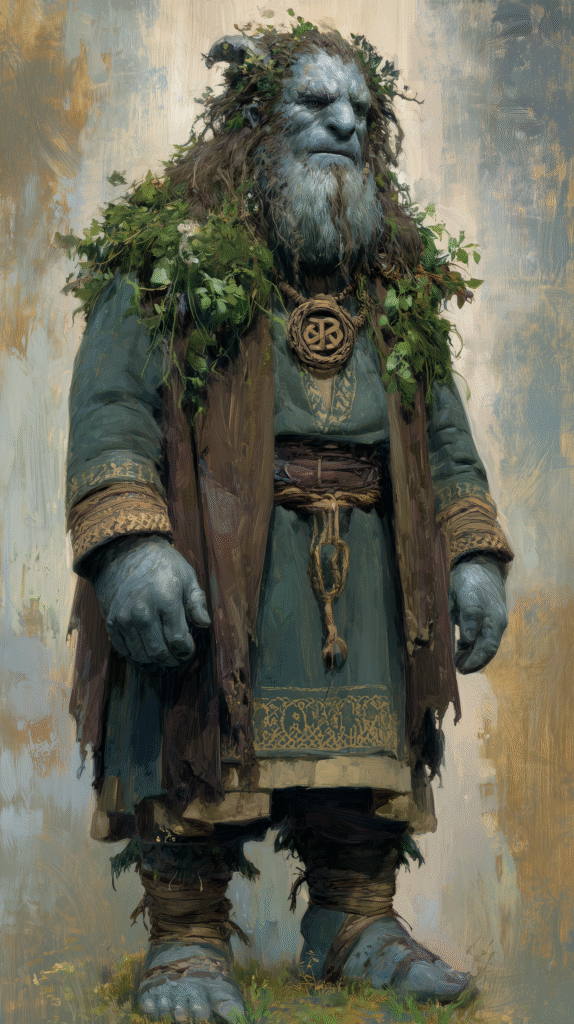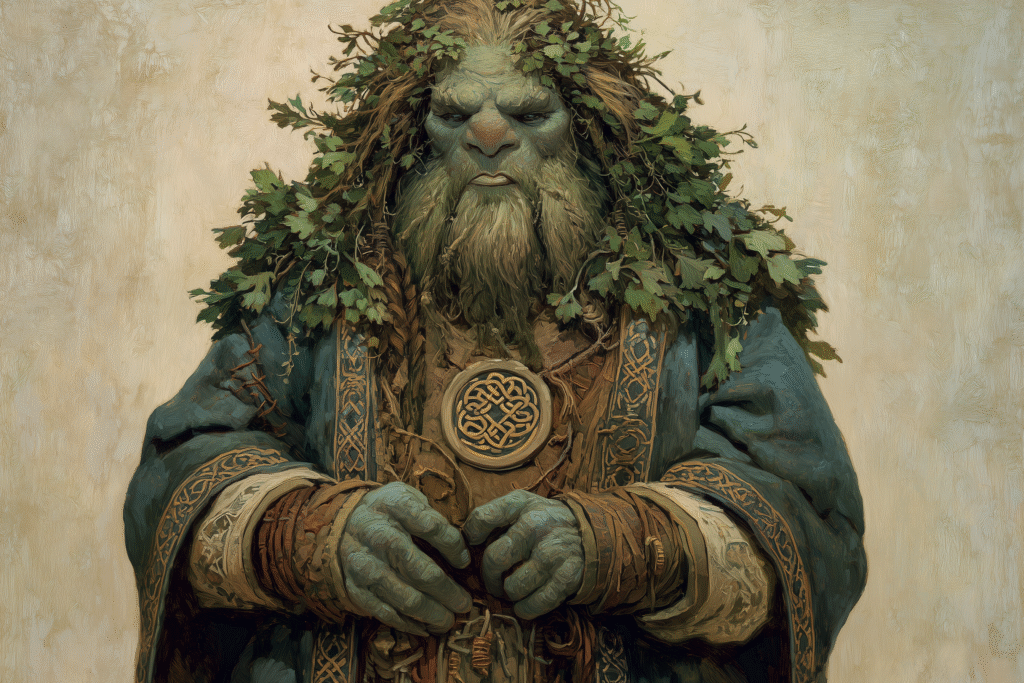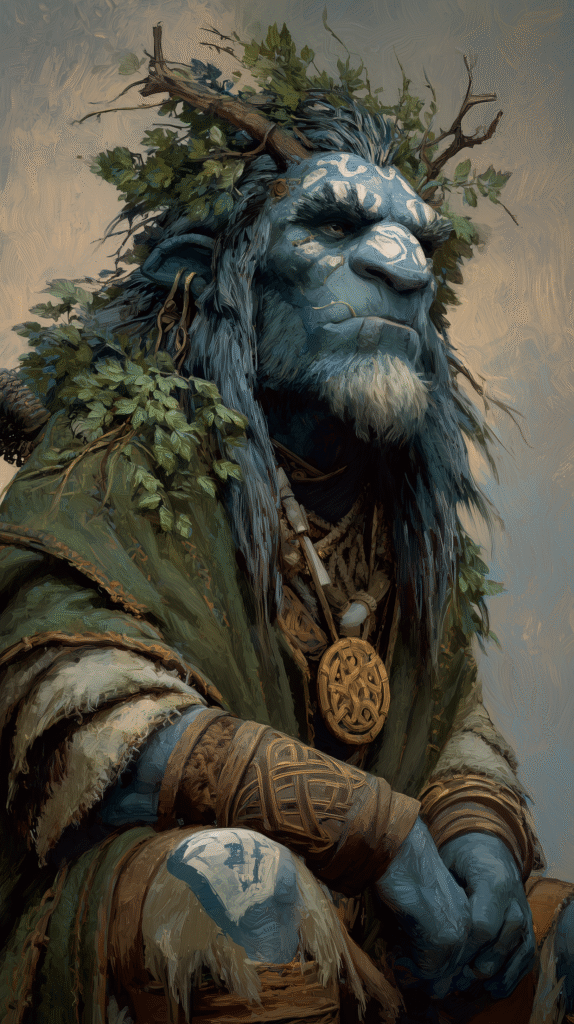Firbolg, Shepherd of the Silent Glade
“Don’t be fooled by their calm voice and flower crown—the Firbolg is a vanishing giant with forest magic and strength that can break your bones or your expectations.”

Towering at over seven feet tall, Firbolgs possess a powerful but unassuming physique, their broad shoulders draped in natural cloaks of moss, bark, and woven flora. Their skin ranges from dusky gray-blue to muted forest green, often mottled like stone or lichen. Elongated ears, flat, gentle noses, and deep-set eyes glowing softly with gold or silver hues give them a serene, almost elven countenance. Some sport beards braided with twigs and feathers, and their scent carries traces of wild herbs and fresh earth.
Behavior
Firbolgs are deeply introspective, reclusive beings who avoid conflict unless their sacred lands are endangered. Kind yet firm, they act as guardians of balance, intervening only when nature is disrupted. They speak in measured tones, often pausing to consider the harmony of words and action. Firbolgs prize community and cooperation, though their community may consist of animals, trees, and spirits rather than people.
They prefer subtlety over aggression, often using illusion magic, animal messengers, or even misdirection to defuse threats. A Firbolg will often try to scare off or confuse intruders rather than kill them, unless truly provoked.
Habitat
Firbolgs dwell in ancient, untouched forests, often near standing stones, faerie rings, or secluded glades charged with primal magic. Their homes are typically hidden by natural camouflage or illusions, and woven into the land itself—tree-trunk halls, burrows beneath waterfalls, or ruins reclaimed by nature. Their territories are wild sanctuaries, teeming with flora and fauna rarely seen elsewhere.
Modus Operandi
Operating as silent wardens, Firbolgs use a mix of druidic magic, stealth, and environmental manipulation to monitor and defend their domains. They cast spells like Detect Magic, Disguise Self, or Animal Messenger to gather information without revealing themselves. If necessary, they use their Hidden Step ability to vanish, reposition, or intimidate foes. In battle, they strike from concealment, use the terrain, and target destructive intruders first—preferring nonlethal solutions.
Motivation
A Firbolg’s actions are governed by a deep-rooted devotion to natural harmony. They believe all life has its place and see themselves as servants of the forest’s will, rather than its masters. Many act on visions, omens, or seasonal cycles, interpreting these as directives from the land itself. They are not easily swayed by politics or coin, but can be moved by acts of selflessness, resonance with nature, or threats to the ancient balance they swore to protect.
Firbolg 5e
Firbolg, Pathfinder
Firbolg Guardian

Large fey (giant-kin), neutral good
Challenge 5 (1,800 XP) | Proficiency Bonus +3
Armor Class 15 (natural armor)
Hit Points 95 (10d10 + 40)
Speed 30 ft.
| STR | DEX | CON | INT | WIS | CHA |
|---|---|---|---|---|---|
| 18 (+4) | 12 (+1) | 18 (+4) | 12 (+1) | 18 (+4) | 14 (+2) |
Saving Throws Con +7, Wis +7
Skills Nature +4, Perception +7, Stealth +4, Animal Handling +7
Damage Resistances cold, lightning
Condition Immunities charmed
Senses darkvision 60 ft., passive Perception 17
Languages Common, Elvish, Sylvan, Giant
Fey Ancestry. The firbolg has advantage on saving throws against being charmed, and magic can’t put it to sleep.
Innate Spellcasting
The firbolg’s spellcasting ability is Wisdom (spell save DC 15, +7 to hit with spell attacks). It can innately cast the following spells, requiring no material components:
- At will: Druidcraft, Detect Magic, Thorn Whip, Guidance
- 2/day each: Entangle, Cure Wounds, Lesser Restoration, Pass without Trace
- 1/day each: Barkskin, Fog Cloud, Spike Growth, Hold Person, Calm Emotions, Moonbeam
Traits
Hidden Step (Recharge 5–6).
As a bonus action, the firbolg magically turns invisible until the start of its next turn, or until it deals damage, makes an attack, or forces a creature to make a saving throw.
Guardian of the Grove.
While in a forest, the firbolg has advantage on Dexterity (Stealth) checks and ignores nonmagical difficult terrain. Once per day in such terrain, it may cast Pass without Trace as an innate spell.
Powerful Build.
The firbolg counts as one size larger when determining its carrying capacity and the weight it can push, drag, or lift.
Actions
Multiattack.
The firbolg makes two melee attacks with its quarterstaff or slam, or one attack and casts a cantrip.
Quarterstaff (Oakbound Staff). Melee Weapon Attack: +7 to hit, reach 5 ft., one target.
Hit: 10 (1d8 + 6) bludgeoning damage. Against aberrations or constructs, it deals an additional 4 (1d6) radiant damage.
Slam. Melee Weapon Attack: +7 to hit, reach 5 ft., one target.
Hit: 11 (2d6 + 4) bludgeoning damage.
Nature’s Rebuke (Recharge 5–6).
Roots erupt in a 30-foot radius around the firbolg. Each enemy in the area must make a DC 15 Constitution saving throw, taking 21 (6d6) force damage on a failed save, or half as much on a success. Creatures that fail are also knocked prone.
Tactics
- Battlefield Control. Opens with Fog Cloud, Entangle, or Spike Growth to slow enemies or block vision.
- Hit-and-Fade. Uses Hidden Step to disappear and reposition between attacks.
- Protector Role. Prioritizes defending its forest, allies, or sacred sites. Prefers subduing over killing.
- Supportive Caster. Casts Cure Wounds or Lesser Restoration to aid allies, and Calm Emotions to prevent violence if possible.
Firbolg

This burly, eight-foot-tall humanoid, dressed in a bearskin and equipped with a massive axe, has long, red hair and a bushy beard.
Firbolg CR 4
XP 1,200
N Large humanoid (giant)
Init +5; Senses low-light vision; Perception +8
DEFENSE
AC 17, touch 10, flat-footed 17 (+2 armor, +1 Dex, +5 natural, –1 size)
hp 39 (6d8+12)
Fort +4, Ref +5, Will +6
OFFENSE
Speed 40 ft.
Melee Huge greataxe +8 (3d8+7/×3)
Ranged rock +5 (2d6+10)
Space 10 ft.; Reach 10 ft.
Special Attacks oversized weapons, rock throwing (120 ft.)
Spell-Like Abilities (CL 6th; concentration +8)
At will—reduce person (DC 13)
1/day—alter self, confusion (DC 16), detect magic, know direction
STATISTICS
Str 20, Dex 13, Con 14, Int 15, Wis 13, Cha 14
Base Atk +4; CMB +10; CMD 21
Feats Deflect Arrows, Improved Initiative, Lightning Reflexes
Skills Climb +12, Knowledge (nature) +6, Perception +8, Sense Motive +5, Stealth +1, Survival +8
Languages Common, Giant
SPECIAL ABILITIES
Oversized Weapons (Ex)
A firbolg can wield weapons sized as if the firbolg were one size category larger.
ECOLOGY
Environment temperate hills or forests
Organization solitary, pair, gang (3–8), clan (9–16), or enclave (10–40)
Treasure standard (leather armor, greataxe, sack with other treasure)
Although they are giants, firbolgs are crafty, cautious, and reclusive. They have learned to distrust most other humanoids except elves, and dwell only in remote places far from civilization’s encroaching grasp, amidst fey and spirits of nature. They live in small, close-knit clans that tend to occupy one large, wooden house surrounded by a field kept for harvest. To supplement the food they grow, they wander the surrounding territory in small gangs hunting and gathering.
Unlike most giants, they do not raid indiscriminately and do not solve all their problems with force and violence.
If pressed into battle, they are cunning combatants who make good use of the terrain, and generally do not kill unless provoked. While they rarely raid, firbolgs love duping smaller creatures out of their food and treasure. Alone or in small groups, they disguise themselves as hapless mountain folk, comely youths, or foreign wanderers to engage in confidence schemes and practical jokes against humanoid neighbors. Firbolgs back up their trickery with their natural magic and incredible strength. Most who encounter a firbolg are never aware of the giant’s true nature.
In their normal form, they look like oversized humans. They wear their hair long and free, and many decorate their skin with intricate designs picked out in blue woad.
Most firbolgs carry their possessions with them in great sacks. Typically, a firbolg’s sack contain several throwing rocks, the firbolg’s personal treasure, and a selection of mundane items stolen, bartered, or otherwise acquired from those the firbolg has recently encountered.
Section 15: Copyright Notice
Pathfinder Roleplaying Game Bestiary 5 © 2015, Paizo Inc.; Authors: Dennis Baker, Jesse Benner, John Bennett, Logan Bonner, Creighton Broadhurst, Robert Brookes, Benjamin Bruck, Jason Bulmahn, Adam Daigle, Thurston Hillman, Eric Hindley, Joe Homes, James Jacobs, Amanda Hamon Kunz, Ben McFarland, Jason Nelson, Thom Phillips, Stephen Radney-MacFarland, Alistair Rigg, Alex Riggs, David N. Ross, Wes Schneider, David Schwartz, Mark Seifter, Mike Shel, James L. Sutter, and Linda Zayas-Palmer.
FIRBOLG SOCIETY
Firbolgs live in remote forests and hills. These giant-kin distrust most other civilized races, and stay well away from them. They keep on even terms with druid and the faerie creatures, including elves, neither asking nor giving much, but avoiding insult or injury. Strangers are met with caution, frequently in illusionary disguise as one of their own race. They do not attack or kill without reason, but do enjoy pranks, particularly those that relieve strangers of treasure.
Their society is close-knit and centered around the family or clan. The clans live apart from each other, existing as gatherers and sometimes nomads. Their homes are huge, single-story, wooden houses with stout walls and a central fireplace opening in several directions in the common room. When great decisions are needed, the clans involved meet in an enclave. This happens at least once a year at the fall solstice, just to celebrate if nothing else. The shamans preside over these events, and settle any disputes between clans.
They live off the land and with it. Their homes are built from trees cleared from around the house. The clan does keep a field for harvest, but only enough to supplement their diet. They trade tasks involving great strength for food, usually with other peaceful folk in the forests or hills. Gathering and hunting an area up to 20 miles from their homestead is how they obtain the rest of their food. Meat is used in small quantities for most meals, although major celebrations always include a large roast of some sort.
Although many creatures are capable of killing a firbolg, none hunt them exclusively. They are stronger than most forest beasts, and intelligent creatures know better than to mess with them.
FIRBOLG’S IN FAERIE
Songs of the Sidhe by David Ross
Unlike the fomorian, the firbolg is a being of grace as well as might. Their culture is well-regarded by the fey and mortals alike for its musical and magical accomplishments, and they pay great reverence to their druid and cleric religious leaders as well as their warrior-poet kings and talented magical craftsmen.
The firbolg race is native to both Faerie and Terra, tracing its roots back to giants who took refuge in Faerie from genocidal dragons during the conflict between dragons and giants at the dawn of the Mortal Coil. Most firbolgs display a very fey-like pragmatism and aloofness. They share the fey’s appreciation for the myth of Queen Gloriana and most revere the Wild Hunt.
FIRBOLG CHARACTERS
The favored class of the firbolg is fighter. Most chieftains are fighters. Firbolg clerics are called shamans and can choose two of the following domains: Animal, Earth, or War.
The Firbolg first appeared in the 1e MM II (Gary Gygax, 1983).

 Buy me a coffee
Buy me a coffee